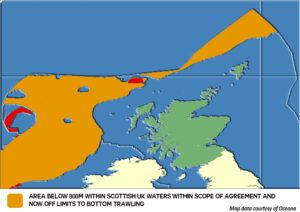 This summer, amidst the complexity of Brexit, the European Parliament took action to reduce the damage wrought by one of the most destructive forms of fishing. A regulation on the deep sea bottom-trawling was finally agreed which established a prohibition of the practice of dragging heavily weighted nets along the seafloor below 800 meters in European Union waters (EEZs) of the North Sea and the northeast Atlantic Ocean. It also prohibits bottom-trawling by EU vessels in the international waters of the central Atlantic off west Africa outside of the Azores, Madeira and Canary Islands EEZs. About time too.
This summer, amidst the complexity of Brexit, the European Parliament took action to reduce the damage wrought by one of the most destructive forms of fishing. A regulation on the deep sea bottom-trawling was finally agreed which established a prohibition of the practice of dragging heavily weighted nets along the seafloor below 800 meters in European Union waters (EEZs) of the North Sea and the northeast Atlantic Ocean. It also prohibits bottom-trawling by EU vessels in the international waters of the central Atlantic off west Africa outside of the Azores, Madeira and Canary Islands EEZs. About time too.
The pre-history of this Regulation was (as this blog helped document) a long and challenging saga and requiring hard and patient campaigning, but the result has now been hailed as one of the most progressive and bold measures taken by the European Union to halt damaging fishing practices. It is hoped that if effectively enforced, then it will put in place the conditions for environmental recovery. The Regulation will apply to approximately 932,000 square kilometres of Europe’s deep sea. But the most crucial area is the 143,000 km2 of primarily continental slope along the European margin between 800 and 1,500 meters depth (the maximum depth to which trawlers drop bottom-towed nets). This area is recognized to be an area of high diversity of fish species and rich in deep-water bottom habitat-forming species such as cold water reefs, coral gardens, deep-sea sponges and infaunnal sediment ecosystems.
Protecting these ecosystems is a long-term investment in the sustainability of our fishing industry. Our campaign members are also engaging in the future discussion around the crucial fisheries management of Offshore MPAs in Scottish waters – where vulnerable marine ecosystems (VMEs) at depths shallower than 800m will need additional protection: more on this in future newsletters.
